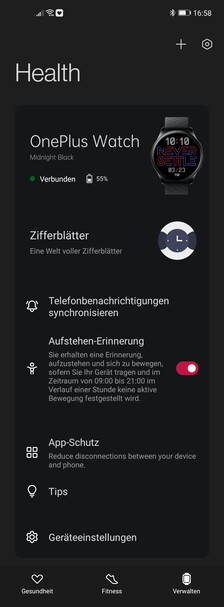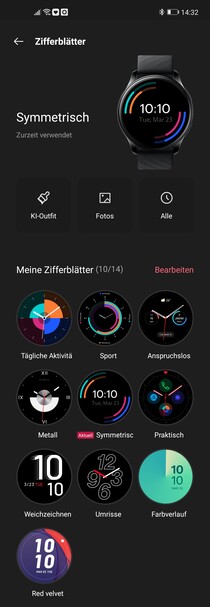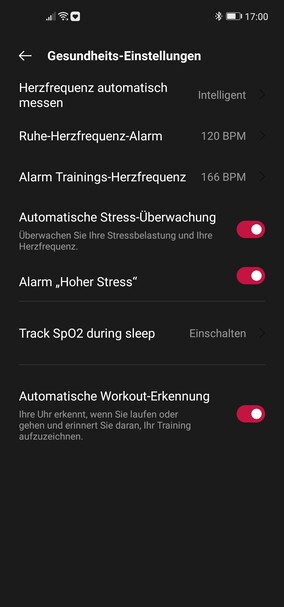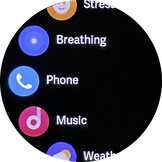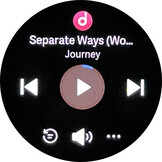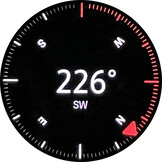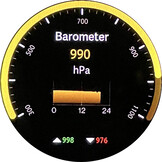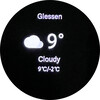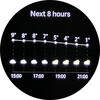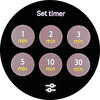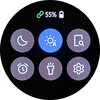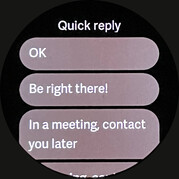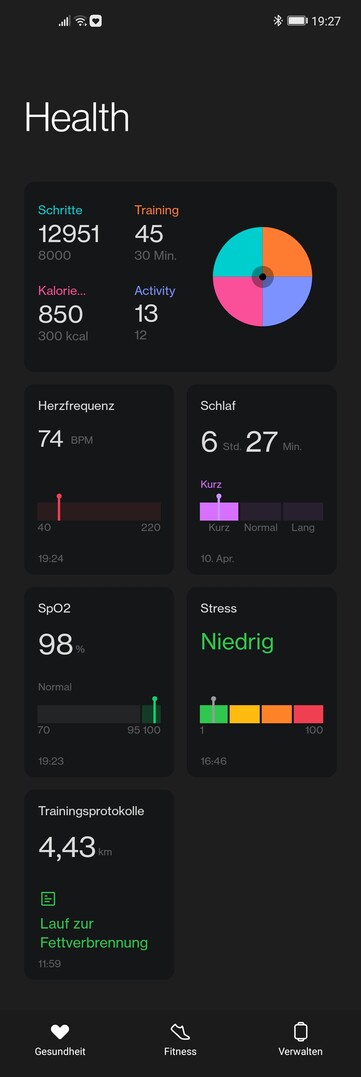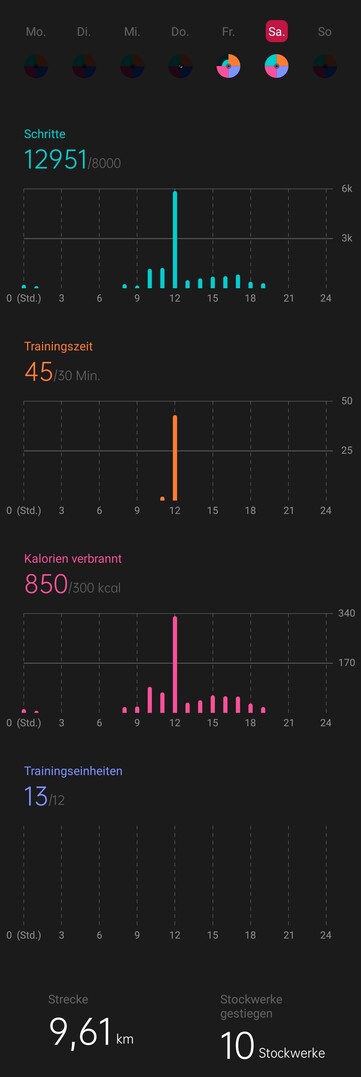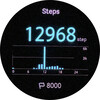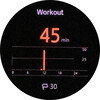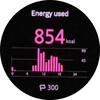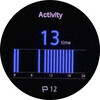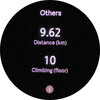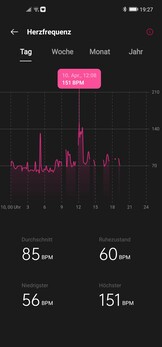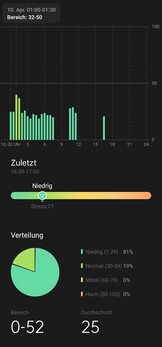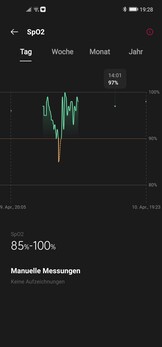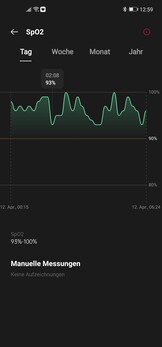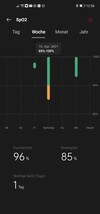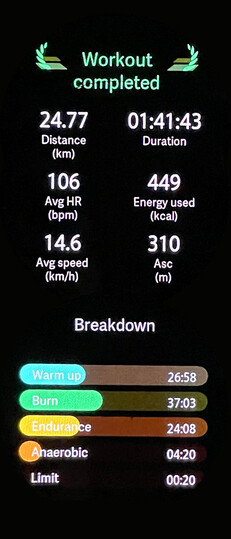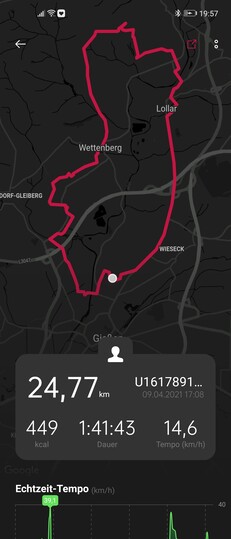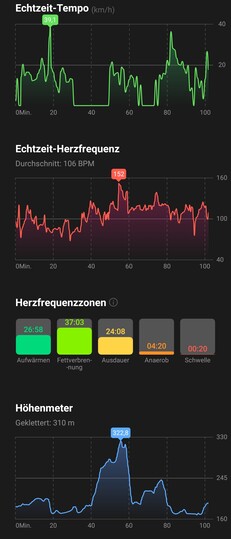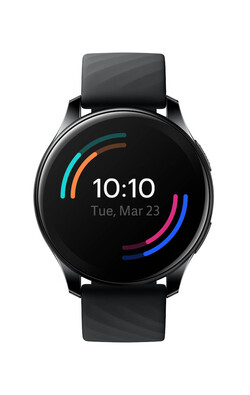OnePlus Watch in review: There are still some teething problems
Case and connectivity – No always-on display
For its first smartwatch, OnePlus has opted for the round design of a traditional 46 mm watch. Right from the start, there are two versions: The Classic Edition and the limited Cobalt Edition. Both are IP68 certified and water resistant up to 5 ATM.
OnePlus provides the Classic Edition with a high-quality stainless steel finish, optionally in anthracite (Midnight Black) or silver (Moonlight Silver). Out of the two buttons on the side, the upper one is branded with the OnePlus name. The 22 mm quick-release band with an Apple-like clasp is made of a fluoroelastomer in the Classic Edition. The Limited Cobalt Edition also includes the sports strap, but a leather strap with a butterfly clasp is attached to it.
OnePlus rounds off the 2.5D glass towards the frame. The Cobalt Limited Edition also features a specially treated sapphire glass with a value of 9 in the Mohs scale; along with high scratch resistance, it's also supposed to provide better brightness. As for the refresh rate, OnePlus proudly speaks of 50 fps. However, we can't confirm that this results in a noticeable advantage for the stylish smartwatch in practice, such as when scrolling through apps or a workout log. On the contrary: When viewing the data in the Activity app, the screen occasionally jumped back one page instead of moving forward when we were actually scrolling in the latter direction. OnePlus does without an always-on display in its first smartwatch. For the time being, OnePlus is considering adding the mode later as the company's product manager announced in a blog post.
The ST32 listed in the specifications is responsible for the display and all performance-demanding processes. Two additional processors are used to ensure the most efficient resource management: An Apollo 3 with low power consumption as the platform for the tracking sensors and a Cypress chip for communication functions like Bluetooth calling.
The Chinese only mention NFC in connection with the version in their native China, where it supports mobile payments and the use of public transportation. Globally, OnePlus has included GPS support, speakers, and a microphone, as well as 4 GB of storage. Out of that, 2 GB is available to store offline music on the Watch.
Setup and handling – With Bluetooth calling
The companion app OnePlus Health is only available in the Play Store so far, but an iOS version is likely. After the first official update of the app, which we initially received via a download link, we were no longer able to open the workout logs, and we were glad that we had already taken the relevant screenshots beforehand.
After setting up a OnePlus account, if you don't already have one, OnePlus assigns the user a string of numbers as username. This can be changed once online at oneplus.com and a profile photo can be added. However, neither of these changes were reflected in the smartphone app during the test, since it continued to display only the number string.
The app is used to set up notifications and health monitoring, to indicate the side on which the watch is worn, and to load additional watch faces onto the watch. It stores up to 14 at a time. Among the 10 preinstalled ones, the complications could be personalized on one; weather info and a call function, for example, could be assigned to it. The AI Outfit function, which supposedly generates a watch face based on the colors and patterns of a photo, was not yet active in the test period, but the option to use a photo directly as a background was.
While the app was mostly translated into German, the Watch software wasn't in German yet, which will surely change before the market launch.
You activate the display by pressing one of the two buttons or by lifting your arm but not by tapping the display. Occasionally, lifting the arm didn't provide enough momentum, and the display still remained dark until the movement was repeated in a more vigorous way.
If you swipe to the left from the watch face, three widgets appear; one for the player, one for the heart rate chart, and one for the sleep duration of the previous night. There are no other widgets so far, and you can't change the order either. The lower button can be personalized, while the upper one opens the app overview. Neither a mail app nor a calendar are available: Events are only announced via the smartphone's notifications.
Initially, OnePlus had considered Google's Wear OS smartwatch operating system. The hardware would've even been ready for Google Pay and Google Assistant with the speaker, microphone, and NFC chip, which is probably only disabled. However, the company decided to use the RTOS operating system, which can't be extended with additional apps, due to the typically weak battery life of Wear OS watches. As a result, the wishes of some users to connect the OnePlus Watch with Strava will remain unfulfilled for the time being. This would theoretically be possible by linking the user account.
Music
The OnePlus Watch at least fulfills another frequently expressed user wish, namely the integration of Spotify, by allowing the installed music player to control the music app that is currently active on the smartphone. This could be the internal smartphone player or the Deezer or Spotify app. In addition, the Health app transfers music tracks in MP3 and AAC formats to a 2 GB section of the internal storage space. The smartwatch plays music stored on the Watch via its speaker or a Bluetooth headset. A bone-conduction headset from Aftershokz served this purpose in the test.
A remote for the smartphone camera was not installed on the test device. However, there's a remote for OnePlus TV that allows adjusting the volume or turning it off.
Telephone and notifications
Incoming calls can be accepted or rejected via the OnePlus Watch. When accepting a call, the user can either use a connected headset or the integrated speaker and microphone. You can choose between the call list, a number pad, or a contact list that can be provided with 30 contacts via the app.
You can respond to messages from social networks with one of four standard responses. The OnePlus Watch wasn't able to display the emojis in our test message, which was rich in graphics.
Health and fitness – Several graphs are still buggy
The smart fitness tracker counts steps, determines the distance covered, the meters of altitude climbed, and the calories burned. The Health app can connect to Google Fit if desired. However, it only transferred the heart rate sensor's data during the test and not the sleep data, which is normally also received by Google Fit.
Heart rate, Heart rate variability, and blood oxygen saturation
In some places, the Health app's charts aren't fully mature yet, and they're even buggy. For example, the bottom chart on the screenshot to the right is empty, and the title "Workout Units" that is above it is incorrect: The numbers indicate that the chart counts hours in which you have been moving and not just sitting - also commonly referred to as "stand goal". Moreover, the intensity or training minutes are already indicated in one of the diagrams above it.
The OnePlus tracker measures your heart rate around the clock if you wish, and it optionally increases the measuring interval during workouts. We aren't completely satisfied here, either, because the log shows gaps in periods where the watch was firmly attached to our wrist. Furthermore, it doesn't generate an ECG.
Blood oxygen saturation (SpO2) is measured automatically at night. In the corresponding graph, the scale of the X axis varies as seen in the two screenshots at the bottom right: If you don't measure saturation during the day, it only includes nighttime data recording as seen in the screenshot to the right. Otherwise, the time axis increases to 24 hours in order to add the manual measurements like the screenshot to the left of it shows. However, the indication of there being "no measurements" under "Manual measurements" is not correct here.
The weekly and monthly view also displays a "Low SpO2" note. A dedicated low-saturation log is also found on the Huawei Watch Fit. While you can change the threshold there, OnePlus locks it at 90%.
Despite all the criticism regarding data processing: The test device did a good job at capturing it. In our measurements, heart rate and oxygen saturation only deviated slightly from the reference values provided by a medically certified pulse oximeter and a chest strap.
Sleep tracking
As far as we can tell, the smartwatch accurately logs the times when the user falls asleep and wakes up, as well as short periods of wakefulness at night. The watch sums up the sleep phases and graphically displays its changes in a pie chart.
The smartphone app evaluates sleep in detail and adds oxygen saturation trends to the diagram. The log highlights readings below 90% with a different color.
Workout tracking
Some users might be disappointed at the mere amount of only 14 different workout modes. Specifically, these include running, a fat-burning run, walking, hiking, cross-country, indoor and outdoor cycling, swimming, elliptical training, rowing machine, badminton, cricket, yoga, and a freestyle workout mode.
There's also little that can be configured outside of potential goals such as targeted calorie burn, a time goal, or a distance goal. An exception is swimming, where more than just the lane length can be specified: In the pool, the tracker also determines SWOLF efficiency in addition to heart rate, distance, calories, and speed, according to the manufacturer.
If you activate automatic workout detection in the Health app, the Watch suggests that you log your activity when running, and it also tracks the route. However, on a 4.68-kilometer standard lap, which we complete with every fitness tracker, the OnePlus Watch only counted 4.43 km during a regularly launched "fat-burning run", resulting in a difference of 250 meters. So far, other trackers with an integrated GPS have shown deviations ranging from 30 to 60 meters along the same short route.
On a bike ride, which was tracked by Komoot at exactly 25 km and by the Apple Watch at 25.19 km, the OnePlus Watch was missing a comparatively modest 300-400 meters. However, it's harder to compare distances of this magnitude anyway.
Battery life
OnePlus specifies a runtime of up to 14 days under an average usage scenario. According to the manufacturer, 25 hours is possible with a permanently active GPS.
Since the manufacturer's specifications usually refer to usage without an always-on display, but its activation has a significant impact on battery life, we activate the mode in our real-world tests to also determine a possible runtime for the case that isn't covered by the manufacturer.
However, the OnePlus Watch doesn't have an always-on display, and consequently, we can only evaluate the manufacturer's specifications. Multiple projections performed throughout the test indicate a consumption of about 8% during days with low usage and 15-20% on days with heavy usage or GPS use. The battery had lost half of its capacity after 4.5 days. During this period, the GPS was active for 2.5 hours.
According to OnePlus, Warp Charge charges the watch for a whole day in just 5 minutes, and 20 minutes on the magnetic pogo-pin adapter are supposed to provide enough power for a week.
Verdict
OnePlus allowed us to test the device before the official market launch, which is unfortunately not usual for wearables. Therefore, it's not surprising that we still found some teething troubles in the test, and this shouldn't be overestimated.
As far as the software is concerned, some things can still be fixed via updates; these include the addition of the missing sleep data in Google Fit, for example, the diagram errors in the Health app, and also the small number of Watch widgets. OnePlus has also already commented on the always-on display, which is not available for the time being, and is considering adding it later. Users who want to extend battery life can still deactivate it.
The hardware is a different story. The sensors measure heart rate and oxygen saturation very well - more precisely than many other current fitness trackers - but the distance determined by the integrated GPS is far behind the actual distance. In any case, as far as our test device is concerned.
Considered on its own, we find the OnePlus Watch to be a good companion for everyday use.
If we compare the OnePlus Watch with the Huawei Watch GT 2 Pro, it performs worse, but it can keep up in terms of looks and starts at a much lower MSRP. The Xiaomi Mi Watch with its more than 100 sports programs and professional analyses offers more than the OnePlus Watch at the same price range and below, if you roughly equate Bluetooth calling with a voice assistant in terms of communication features. Visually, however, the Xiaomi Watch can't keep up with the stainless steel case of the OnePlus Watch. That is also true for most other smartwatches under 200 Euros (~$240).
Price and availability
The Classic version of the OnePlus Watch is already available on the manufacturer's website for $159. Alternatively, you can also keep tabs on Amazon and wait for it to pop up there.












